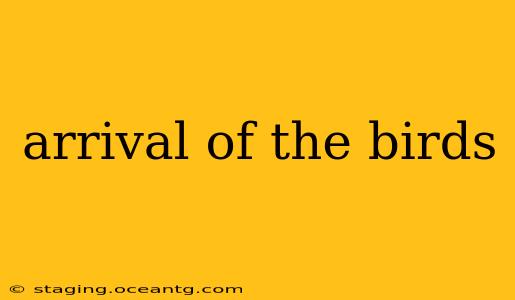The arrival of birds is more than just a pretty sight; it's a vibrant indicator of the changing seasons, a testament to nature's resilience, and a complex ecological event. From the cheerful chirp of the robin to the soaring cry of the hawk, their return heralds the warmth of spring and the renewal of life. But understanding the complexities behind this annual migration requires delving deeper than just appreciating their beauty. This article explores the fascinating phenomenon of bird arrival, examining the factors driving their journeys and the significance of their return to our ecosystems.
Why Do Birds Migrate?
Birds migrate primarily to find optimal conditions for breeding and feeding. During the breeding season, longer daylight hours provide more time for foraging, allowing birds to feed their young more effectively. Many species also seek out areas with abundant insect populations crucial for fledglings' development. Conversely, during winter, food sources in many regions become scarce, forcing birds to migrate to warmer climates where food remains plentiful.
What Triggers Bird Arrival?
The arrival of birds isn't a random event; it's a finely tuned response to environmental cues. These triggers include:
- Day Length: The increasing amount of daylight in spring acts as a powerful internal clock, triggering hormonal changes that prepare birds for migration.
- Temperature: Rising temperatures signal the warming of the environment, making it more hospitable for breeding and foraging.
- Food Availability: The appearance of specific insects or the blossoming of plants indicates the availability of crucial food sources.
- Magnetic Fields: Many birds use the Earth's magnetic field as a navigational aid during their long journeys.
How Do Birds Know Where to Go?
This is a question that has fascinated scientists for decades. While the exact mechanisms are still being researched, several factors contribute to birds' navigational abilities:
- Inherited Routes: Many birds seem to have an innate sense of direction, inheriting migratory routes from their ancestors.
- Learned Behaviors: Young birds often follow experienced adults on their first migration, learning the route through observation.
- Celestial Navigation: Birds can use the sun, moon, and stars to orient themselves during their journeys.
- Landmarks: Familiar geographical features like coastlines, rivers, and mountain ranges can also guide birds during their migrations.
What are the Different Types of Bird Migration?
Bird migration isn't a one-size-fits-all phenomenon. Several types exist, including:
- Complete Migration: Birds travel long distances between breeding and wintering grounds.
- Partial Migration: Only a portion of a bird species migrates, while others remain in their breeding grounds year-round.
- Altitudinal Migration: Birds move to different altitudes within their breeding range, depending on the season.
- Irruptive Migration: Irregular migrations driven by food availability or other unpredictable environmental factors.
How Does Climate Change Affect Bird Arrival?
Climate change presents significant challenges to migrating birds. Shifting weather patterns, altered food availability, and changes in habitat can disrupt established migratory routes and timing. This can lead to mismatches between bird arrival and the availability of food and nesting sites, potentially impacting population numbers.
What Can We Do to Help Migrating Birds?
Protecting and restoring habitats is crucial for supporting migrating birds. This includes conserving forests, wetlands, and other vital ecosystems. Reducing pesticide use and minimizing light pollution can also help create safer and more productive environments for these incredible creatures.
Frequently Asked Questions about Bird Arrival:
What time of year do birds arrive? The timing varies greatly depending on the species and location, but generally, many birds arrive in spring, coinciding with warmer temperatures and increased food availability.
How far do birds migrate? The distance varies considerably, from short local movements to thousands of miles across continents.
Do all birds migrate? No, some birds are resident species, remaining in the same area year-round.
How do birds find their way back to the same place each year? A combination of inherited routes, learned behaviors, celestial navigation, and landmarks helps birds navigate their migratory journeys.
Why is bird arrival important? The arrival of birds is a crucial ecological event, signaling the start of the breeding season and contributing to the biodiversity and health of ecosystems. Their presence is vital for pollination, seed dispersal, and pest control.
The arrival of birds is a breathtaking spectacle, a testament to the wonders of the natural world. By understanding the complexities of their migration and the challenges they face, we can better appreciate and protect these fascinating creatures and their vital role in our ecosystems.
